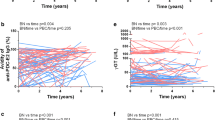Abstract
Clinical significance of anti-Saccharomyces cerevisiae antibody (ASCA) and its prevalence in Chinese primary biliary cirrhosis (PBC) patients have not been characterized and therefore needs to be defined. Enzyme-linked immunosorbent assay was used to test ASCA in sera from 198 PBC patients, 85 patients with other liver diseases (OLD) and 35 health controls (HC). Indirect immunofluorescence was used to detect anti-mitochondrial antibodies (AMA) in PBC. Results showed that the frequency of ASCA in PBC, 29.8 %, was higher than other disease groups. And ASCA occurred more frequently in PBC patients with positive anti-gp210 than the negative ones. Also, ASCA was detected in 7 out of 15 PBC negative for AMA. Some liver-related biochemical indices and inflammatory indices were significantly higher in PBC patients with positive ASCA (p < 0.05). In conclusion, the prevalence of ASCA in Chinese PBC patients is 29.8 %. PBC patients with positive ASCA are associated with more severe liver injury, and ASCA-IgA might be related to disease activity of PBC.

Similar content being viewed by others
References
Kaplan MM, Gershwin ME (2005) Primary biliary cirrhosis. N Engl J Med 353:1261–1273
Lazaridis KN, Juran BD, Boe GM et al (2007) Increased prevalence of antimitochondrial antibodies in first-degree relatives of patients with primary biliary cirrhosis. Hepatology 46:785–792
Nakamura M, Kondo H, Mori T et al (2007) Anti-gp210 and anti-centromere antibodies are different risk factors for the progression of primary biliary cirrhosis. Hepatology 45:118–127
Miyachi K, Hankins RW, Matsushima H et al (2003) Profile and clinical significance of anti-nuclear envelope antibodies found in patients with primary biliary cirrhosis: a multicenter study. J Autoimmun 20:247–254
Hu CJ, Zhang FC, Li YZ et al (2010) Primary biliary cirrhosis: what do autoantibodies tell us? World J Gastroenterol 16:3616–3629
Bossuyt X (2006) Serologic markers in inflammatory bowel disease. Clin Chem 52:171–181
Reese GE, Constantinides VA, Simillis C et al (2006) Diagnostic precision of anti-Saccharomyces cerevisiae antibodies and perinuclear antineutrophil cytoplasmic antibodies in inflammatory bowel disease. Am J Gastroenterol 101:2410–2422
Muratori P, Muratori L, Guidi M et al (2003) Anti-Saccharomyces cerevisiae antibodies (ASCA) and autoimmune liver diseases. Clin Exp Immunol 132:473–476
Sakly W, Jeddi M, Ghedira I (2008) Anti-Saccharomyces cerevisiae antibodies in primary biliary cirrhosis. Dig Dis Sci 53:1983–1987
Fagoonee S, De Luca L, De Angelis C et al (2009) Anti-Saccharomyces cerevisiae as unusual antibodies in autoimmune hepatitis. Minerva Gastroenterol Dietol 55:37–40
Papp M, Norman GL, Vitalis Z et al (2010) Presence of anti-microbial antibodies in liver cirrhosis—a tell-tale sign of compromised immunity? PLoS ONE 5:e12957
Liu HY, Deng AM, Zhou Y et al (2006) Analysis of HLA alleles polymorphism in Chinese patients with primary biliary cirrhosis. Hepatobiliary Pancreat Dis Int 5:129–132
Invernizzi P, Battezzati PM, Crosignani A et al (2003) Peculiar HLA polymorphisms in Italian patients with primary biliary cirrhosis. J Hepatol 38:401–406
Heathcote EJ (2000) Management of primary biliary cirrhosis. The American Association for the Study of Liver Diseases practice guidelines. Hepatology 31:1005–1013
Annese V, Piepoli A, Perri F et al (2004) Anti-Saccharomyces cerevisiae mannan antibodies in inflammatory bowel disease: comparison of different assays and correlation with clinical features. Aliment Pharmacol Ther 20:1143–1152
Cabiscol E, Piulats E, Echave P et al (2000) Oxidative stress promotes specific protein damage in Saccharomyces cerevisiae. J Biol Chem 275:27393–27398
Liu B, Shi XH, Zhang FC et al (2008) Antimitochondrial antibody-negative primary biliary cirrhosis: a subset of primary biliary cirrhosis. Liver Int 28:233–239
Muratori P, Muratori L, Ferrari R et al (2003) Characterization and clinical impact of antinuclear antibodies in primary biliary cirrhosis. Am J Gastroenterol 98:431–437
Hu C, Deng C, Song G et al (2011) Prevalence of autoimmune liver disease related autoantibodies in Chinese patients with primary biliary cirrhosis. Dig Dis Sci 56:3357–3363
Marrakchi R, Bougatef K, Moussa A et al (2009) 3020insC insertion in NOD2/CARD15 gene, a prevalent variant associated with anti-Saccharomyces cerevisiae antibodies and ileal location of Crohn’s disease in Tunisian population. Inflamm Res 58:218–223
Gaj P, Habior A, Mikula M et al (2008) Lack of evidence for association of primary sclerosing cholangitis and primary biliary cirrhosis with risk alleles for Crohn’s disease in Polish patients. BMC Med Genet 21(9):81
Annese V, Piepoli A, Latiano A et al (2005) HLA-DRB1 alleles may influence disease phenotype in patients with inflammatory bowel disease: a critical reappraisal with review of the literature. Dis Colon Rectum 48:57–64
Acknowledgments
This work was supported in part by funding from the National Science Technology Pillar Program in the 11th Five-year Plan (Grants 2008BAI59B02 and 2008BAI59B03), the National Natural Science Foundation of China (No. 81072486 and 30872331) and the Youth Foundation of Beijing Union Medical College Hospital (No. I10143).
Conflict of interest
The authors declare that they have no conflict of interest.
Author information
Authors and Affiliations
Corresponding author
Additional information
Chaojun Hu, Chuiwen Deng and Shulan Zhang equally contributed to this work and should be considered as the first authors.
Rights and permissions
About this article
Cite this article
Hu, C., Deng, C., Zhang, S. et al. Clinical significance and prevalence of anti-Saccharomyces cerevisiae antibody in Chinese patients with primary biliary cirrhosis. Clin Exp Med 13, 245–250 (2013). https://doi.org/10.1007/s10238-012-0207-4
Received:
Accepted:
Published:
Issue Date:
DOI: https://doi.org/10.1007/s10238-012-0207-4




